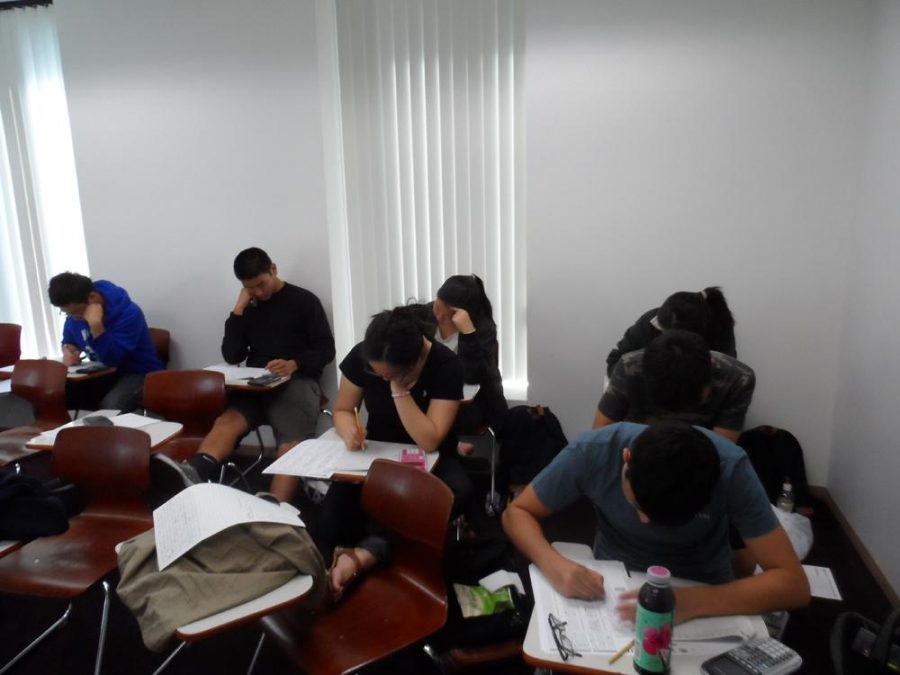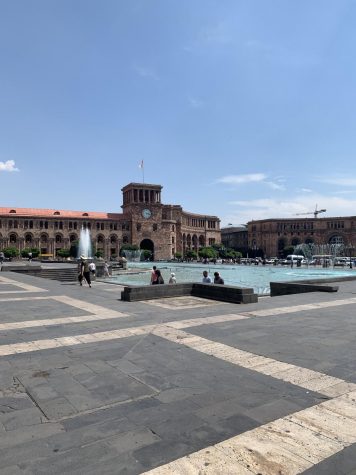Soldiering through the SAT
Students are hard at work in practicing for the SAT. They practice every week with 3.5 hour tests, coming from areas near and far to boost their SAT grades.
“Ericka, you’re staying for writing,” announced Eunice Cho, the assistant director of the Los Angeles Branch of Elite Educational Institute. Sitting with a resigned look in the small classroom, I sighed and picked up my backpack to move to the next room. I had already known about my writing quiz results, so the fact that I had to stay after class to make up a “failed” writing quiz was no surprise. (In my defense, it was still an 80%)
As an upcoming junior, my parents had found it to be of utter importance to enroll me in an SAT preparatory class. But programs that would raise my score up marginally — there is Kaplan, which would provide tools for the SAT and help me look for tutors, or A Perfect Score, a West LA-based tutoring center that centers on individual needs — would not suffice. Therefore, my parents chose Elite Educational Institute, a tutoring center known for its rigorous curriculum and stellar results.
Elite Educational Institute first began in Rowland Heights in 1987, established by J. Patrick Park. In 1990, Elite opened its second branch in Los Angeles. At that time, Elite had no set, clear system. “I was a student at Elite, too,” Cho said. In these early days, there were no detentions or uniform quizzes, and classes had been left to their own devices, according to Cho.
That being said, some Elite students would grieve for the past. Specifically in the LA branch, students can get a maximum of two wrong on the 15-question quizzes, and five wrong on the 50-question vocabulary quizzes. Many students bemoan and fear this system, while Elite insists that it is good for us (we’re still trying to work that out).
In 2013, Elite has branched out quite a bit. According to the company’s website, Elite now has 36 branches in six nations, including Canada, China, South Korea and Turkey. Today, the program is planning to open new branches in Thousand Oaks and La Crescenta, and it will expand operations into China.
Hundreds, even thousands of students, are enrolled in the various Elite branches. Elite offers tutoring in a variety of subjects, such as the ACT, AP classes, regular classes, foreign languages, the PSAT, but most students, including myself, go for SAT preparation.
But SAT prep students aren’t all lumped together in one room. There are many different programs, and classes that range anywhere from $440 per month to $3000 for a full 14 weeks. To many, this price is ludicrous. Splurging on preparatory programs is a luxury when they’re struggling to pay for rent or food. For lower income families, Glendale Unified School District offers preparatory programs for the SAT at more affordable prices.
Meanwhile, for the fall, Elite Educational Institute has its fall session, which started in the beginning of the school year, and for the winter, Elite has its 8-day boot camp. During the summer, there is the “SAT Boot Camp,” which students attend for four or five days a week for eight weeks to receive in-depth instruction.
Students who are looking for an even more rigorous program take the “SAT 2100 Plus Program,” which takes place all summer and is divided into further levels (2100-A, 2100-B, 2100-C). During the summer portion of “2100 Plus,” as Elite veterans and tutors call it, we go on Fridays to take the practice tests, while on Saturdays, we go for eight hours of instruction.
During the fall portion of this program, we can either choose to do the practice tests for four hours on a weekday and four hours of instruction on Saturdays, or group the practice tests and instruction together for eight hours every Saturday. I chose the latter for the fall, but like all other Elite students, I had four hours of testing on Fridays and eight hours of instruction on Saturdays during the summer.
However, to determine which tier of the “2100 Plus” program I’d be in, I first had to take a diagnostic test. “The [achievement] gap is so wide,” Cho said. “When we get new students, we have some who score, like 990, and then we have some score who about 2320.”
Unfortunately, I was not one of those outstanding students with a nearly perfect score. Just like any of the other practice tests, this test was a struggle, asking many questions that referred back to passages and forced me to recall the triangle properties I learned in geometry. Never having taken such a test before, I was flustered by the limited amount of time and the vast number of questions. Red-faced and furiously scribbling in answers as they came to me, I was disappointed with a score of 1990, a far cry from the 2100 or better that I was expected to receive.
But I wasn’t disappointed for long.
After being presented with the program materials — a swanky Elite backpack, a neat Elite binder, an intimidating set of SAT vocabulary flashcards, and an exhaustive book of articles — I was officially enrolled as an Elite student.
The Friday of the first practice test, I was confused to be told to circle the answers in my booklet as well as to mark them on the answer sheet. Then, I had another puzzling booklet handed to me. Cho explained that we were supposed to comb through the answers that we had marked in our booklets and mark our mistakes. After doing so, we were to explain why we had gotten those questions wrong in our booklets, which were actually review packets. Such tedious work actually helped me realize what my strengths and weaknesses are.
The following Saturday, I went into class completely oblivious to the work awaiting me. My first class was math, a usually shaky subject for me. As the teacher gave us the packet and flung the lesson and quiz at us (in which we could only get two wrong and not have detention), I had to admit, I was a bit overwhelmed.
But once I learned key words to look for and a way to read the questions quickly throughout the weeks, I realized that the SAT, at least the math portion, was not that bad. So why had my practice test score been so low, especially in the math section? As our teacher repeated like a mantra, “Remember, you’re all too smart for the SAT.”
Those of us who had gotten low scores on the diagnostic and the practice test had one thing in common: an overly analytical mind. Out of paranoia, we tried to look for things that weren’t even in the problem. Elite had to change the entire way we think when we take the real SAT.
Next up was the critical reading class. Here, we learned how to read those long, tedious passages and answer questions as quickly as possible. The word “indicates” became my best friend because I was told all I had to look for were the exact same words in the passage or a paraphrase of those words.
Probably the most grueling part of the SAT was also the vocabulary that came as part of critical reading. I’ve failed a vocabulary quiz before because the sheer number of words is a struggle to deal with. About 500 words per week during the summer and 100 words per week during the fall I crammed all those words into my head at the last minute. I was too frightened to face the matter head-on, and put it off for as long as possible. I admit, I’m not student of “paragon” and I have a “penchant” for procrastination, at least when it comes to these “formidable” SAT words.
My worst class was definitely writing. In this class, we learned grammar rules and tenses. Parallelism, noun cases, the subjunctive (mini lesson: Beyonce has always been right and Justin Bieber hasn’t; it’s supposed to be “If I were a boy,” not, “If I was your boyfriend”), the past perfect, and the present perfect were all such vague, abstract concepts that I could not grasp. I was frustrated by these ideas, and I’d often fail the quizzes. Paradoxically, writing was also the subject I’ve gotten a perfect score in for any of the practice tests I’ve taken.
During the summer, there were additional classes called “articles” and “essay.” In the articles class, we’d use the formidable articles packet we’d gotten earlier to discuss the material it presented, ranging anywhere from scientifical research to anecdotes. In all aspects, it was an extension of the critical reading class. Meanwhile, in the essay class, we’d brainstorm ideas to use for the essay portion of the SAT, and write theses and topic sentences. Relatively easy classes, especially when compared to the cleverness needed to survive in the other three classes.
Although people were shifted around and new material always presented, my dread for detention was consistent. Staying half an hour after class to make up a quiz that I’d “failed” (meaning less than 90%), was awful, partially because of the shame, and partially because I wanted to go home.
I had to get perfect scores on all the quizzes for the detentions to go away; three failed detentions meant that I could be demoted to a lower class. But I persistently clung on. I made up all my detentions and finished the program with a clean record.
Elite does not just specialize in giving its students program materials and instruction; it does everything to ensure that all its students go to a good college based on their tastes. Therefore, there are many programs such as Elite’s leadership programs to teach students how to manage their time and be good leaders. College admission counseling sessions help students know how to eloquently state who they really are for their personal statement. And to make sure that students do as well as possible, Elite also has a few review sessions after the “2100 Plus” program concludes.
One of the more notable program would be the Elite Vision Expo, an annual convention open to all Elite students. It doesn’t seem like much, just another gathering meant to nudge us towards our dream schools, but to me, it was more of a beneficial push.
On August 3, I was able to hear what goes on in the minds of admissions officers as they chose students for their universities. As expected, they looked for skilled students with good grades. Surprisingly, while well-roundedness is a nice trait, I was bluntly told that many schools look for students who excel in their own fields.
For instance, colleges would rather have a bunch of students who each specialize in music, dance, art, math and literature than have a handful of students who can do mildly well in all those subjects. Sitting with pen poised in hand, I scribbled all of this down, hoping to be able to decipher these notes later to actually utilize them.
Elite Vision Expo has many panels and programs, such as panels by people who work in certain fields and college alumni, but the biggest two events during the day were the talent show and quiz bowl. Five students were selected from a pool who had emailed submissions of themselves dancing, singing, or playing the piano. Meanwhile, I stood fidgeting on the sidelines, waiting to go up for the quiz bowl.
Each branch had chosen a few students to compete in this quiz bowl, and I was one of the ones to represent LA. Unfortunately, I was out by the fifth round when I completely forgot all my SAT vocabulary words. Many of my teammates were devastatingly wiped out when they forgot what the name of the Seven Dwarves, a question that still makes me smack my forehead to this day.
After the rigorous curriculum of Elite, I can confidently say that I know what I’m doing when I see any SAT-style questions. If anything, I can at least answer all the questions within the given time frame. But, of course, I’ve learned more than time management. I’ve learned how to strategize for the test: what to look for, how to phrase things, and how to use given clues to my advantage. Fourteen weeks have prepared me not just for the October 5 SAT, but also for any tests that come my way. I can proudly say that I am an Elite veteran.

INTERESTS/HOBBIES: Concert-going, book-reading, pun-saying, cover-making, prose-writing
EXTRACURRICULAR ACTIVITIES: GMG Regional Board (VP of...








